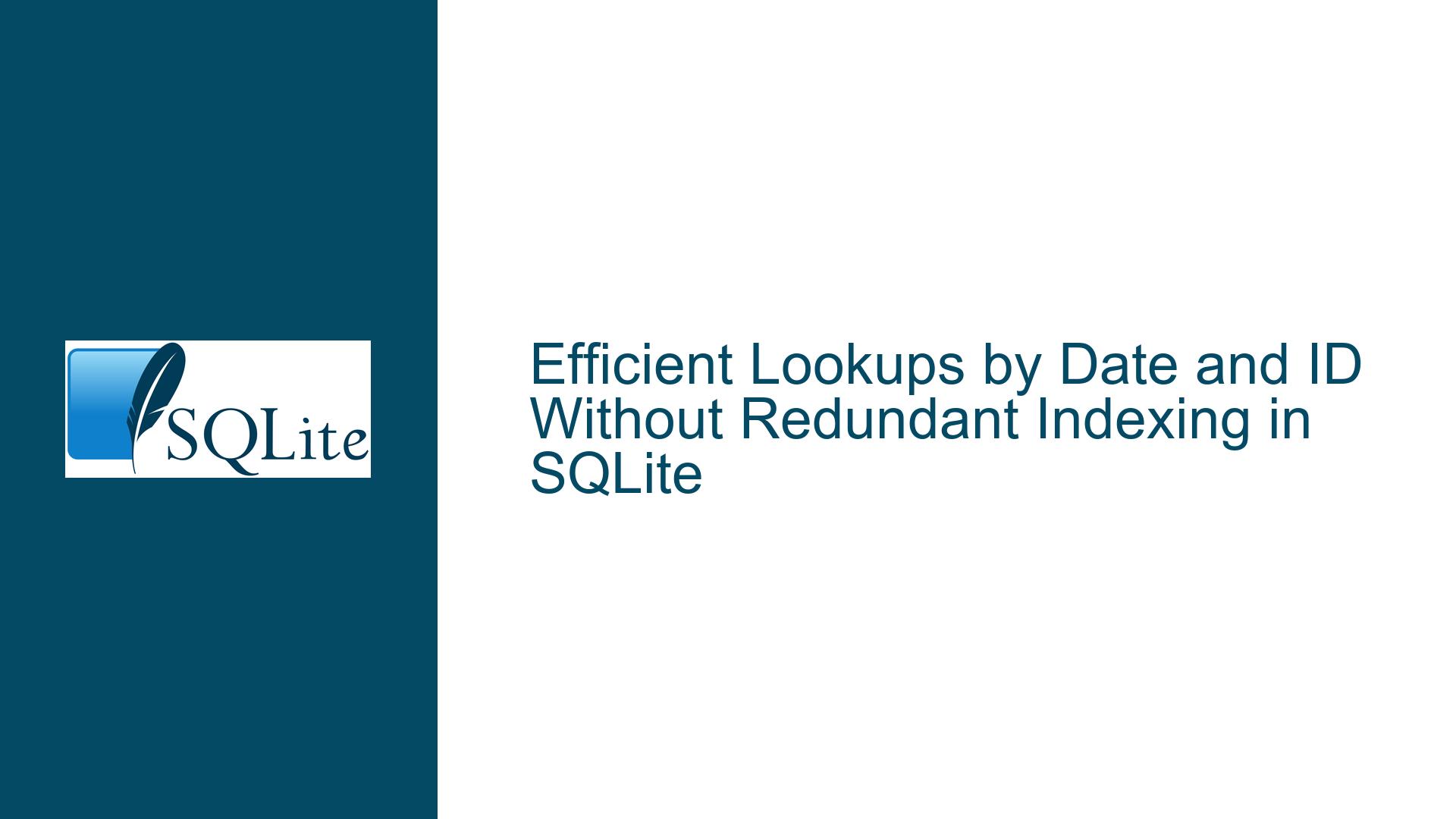Efficient Lookups by Date and ID Without Redundant Indexing in SQLite
Understanding the Need for Dual-Column Order and Efficient Lookups
In database design, particularly in SQLite, the need to efficiently query data based on multiple columns that share a logical order is a common challenge. Consider a scenario where a table has two columns: a date column and an ID column. The ID column is strictly increasing by date and is set as the primary key. Both columns are essential for different queries, and the goal is to enable efficient lookups by either column without duplicating data through redundant indexing.
The primary issue here is that while the ID column is already indexed (as it is the primary key), the date column also needs to be indexed to facilitate efficient lookups. However, creating a separate index on the date column would duplicate the ordering information already present in the primary key index, leading to unnecessary storage overhead and potential performance degradation during write operations.
The core challenge is to express that the date and ID columns share the same order, allowing the database to leverage the existing primary key index for lookups on either column without requiring an additional index. This would eliminate redundancy while maintaining efficient query performance.
Exploring the Constraints and Implications of Indexing in SQLite
To understand why this is a problem, we need to delve into how SQLite handles indexing and query optimization. SQLite uses B-trees for indexing, which are efficient for range queries and equality lookups. When a table has a primary key, SQLite automatically creates a unique index on that key. This index allows for fast lookups and range scans based on the primary key.
However, when you need to query based on another column, such as date, SQLite cannot use the primary key index unless the query explicitly involves the primary key. This is because the primary key index is structured around the primary key column(s) and does not inherently include information about other columns, even if those columns are logically ordered in the same way.
In the given scenario, the ID and date columns are strictly ordered relative to each other. This means that if you know the value of one, you can infer the position of the other within the table. However, SQLite’s query planner does not automatically recognize this relationship. As a result, a separate index on the date column is typically required to enable efficient lookups by date.
Creating a separate index on the date column introduces redundancy because the ordering information is already present in the primary key index. This redundancy not only increases storage requirements but also impacts write performance, as every insert, update, or delete operation must maintain both the primary key index and the additional index on the date column.
Leveraging SQLite Features to Optimize Dual-Column Lookups
To address this issue, we need to explore SQLite’s features and capabilities that allow us to optimize dual-column lookups without redundant indexing. One approach is to use a covering index, which includes all the columns needed by a query, allowing the query to be satisfied entirely from the index without accessing the underlying table.
In the context of the given scenario, we can create a composite index on both the ID and date columns. This composite index would allow SQLite to efficiently query based on either column, as the index would contain both columns in a single structure. However, this approach still involves creating an additional index, which reintroduces the issue of redundancy.
A more elegant solution is to use a WITHOUT ROWID table. In SQLite, a WITHOUT ROWID table stores its data directly in the primary key index, eliminating the need for a separate rowid and reducing storage overhead. By defining the primary key to include both the ID and date columns, we can ensure that the table’s data is ordered by both columns, enabling efficient lookups by either column without requiring an additional index.
Here’s how this can be implemented:
CREATE TABLE IF NOT EXISTS events (
id INTEGER NOT NULL,
date TEXT NOT NULL,
PRIMARY KEY (id, date)
) WITHOUT ROWID;
In this schema, the id column is the primary key, and the date column is included in the primary key definition. The WITHOUT ROWID clause ensures that the table’s data is stored directly in the primary key index, which is ordered by both id and date. This allows SQLite to efficiently query the table based on either column without requiring an additional index.
Validating the Solution with Query Plans
To confirm that this approach achieves the desired efficiency, we can examine the query plans for lookups based on both the id and date columns. Using the EXPLAIN QUERY PLAN statement in SQLite, we can analyze how the database engine processes each query.
For a lookup by id:
EXPLAIN QUERY PLAN SELECT * FROM events WHERE id = 123;
The query plan should indicate that SQLite is using the primary key index to perform the lookup, as the id column is part of the primary key.
For a lookup by date:
EXPLAIN QUERY PLAN SELECT * FROM events WHERE date = '2024-12-27';
The query plan should show that SQLite is using the primary key index to perform the lookup, as the date column is also part of the primary key. This confirms that the WITHOUT ROWID table structure allows efficient lookups by either column without requiring an additional index.
Addressing Potential Limitations and Edge Cases
While the WITHOUT ROWID approach provides an elegant solution to the problem, it is important to consider potential limitations and edge cases. One limitation is that WITHOUT ROWID tables do not support certain features, such as AUTOINCREMENT on the primary key. Additionally, WITHOUT ROWID tables may have different performance characteristics compared to regular tables, particularly for large datasets or complex queries.
Another consideration is the impact of updates on the primary key. In a WITHOUT ROWID table, updating the primary key columns requires rewriting the entire row, which can be more expensive than updating non-key columns in a regular table. This is because the primary key determines the physical location of the row in the table’s storage structure.
To mitigate these limitations, it is crucial to carefully design the schema and evaluate the specific requirements of the application. For example, if the id column is immutable and the date column is rarely updated, the WITHOUT ROWID approach is likely to be effective. However, if the primary key columns are frequently updated, alternative strategies may need to be considered.
Exploring Alternative Strategies for Dual-Column Lookups
If the WITHOUT ROWID approach is not suitable for a particular use case, there are alternative strategies for optimizing dual-column lookups in SQLite. One such strategy is to use a covering index that includes both the id and date columns, along with any other columns needed by the queries.
For example:
CREATE INDEX idx_events_id_date ON events(id, date);
This index allows SQLite to efficiently query the table based on either the id or date column, as the index contains both columns. However, this approach still involves creating an additional index, which introduces some redundancy.
Another strategy is to use a materialized view or virtual table to precompute and store the results of frequently executed queries. This can reduce the need for redundant indexing by offloading the query processing to a separate structure. However, this approach introduces additional complexity and may not be suitable for all use cases.
Best Practices for Schema Design and Query Optimization
To achieve optimal performance and minimize redundancy in SQLite, it is essential to follow best practices for schema design and query optimization. Here are some key recommendations:
Use
WITHOUT ROWIDTables Judiciously: WhileWITHOUT ROWIDtables can eliminate redundancy and improve query performance, they are not a one-size-fits-all solution. Carefully evaluate the specific requirements of your application before using this feature.Leverage Composite Indexes: When multiple columns are frequently queried together, consider creating composite indexes that include all relevant columns. This can reduce the need for multiple single-column indexes and improve query performance.
Minimize Redundant Indexing: Avoid creating indexes that duplicate information already present in other indexes. This not only reduces storage overhead but also improves write performance.
Analyze Query Plans: Use the
EXPLAIN QUERY PLANstatement to analyze how SQLite processes your queries. This can help you identify inefficiencies and optimize your schema and queries accordingly.Consider Application-Specific Requirements: The optimal schema design and indexing strategy depend on the specific requirements of your application. Consider factors such as query patterns, data volume, and update frequency when designing your database.
Conclusion: Achieving Efficient Dual-Column Lookups in SQLite
In summary, the challenge of enabling efficient lookups by two columns that share a logical order in SQLite can be addressed through careful schema design and query optimization. By leveraging SQLite’s WITHOUT ROWID feature, you can eliminate redundant indexing and achieve efficient lookups by either column. Alternatively, composite indexes and covering indexes can be used to optimize query performance, albeit with some redundancy.
Ultimately, the best approach depends on the specific requirements of your application. By following best practices for schema design and query optimization, you can ensure that your SQLite database performs efficiently and scales effectively to meet your needs.






